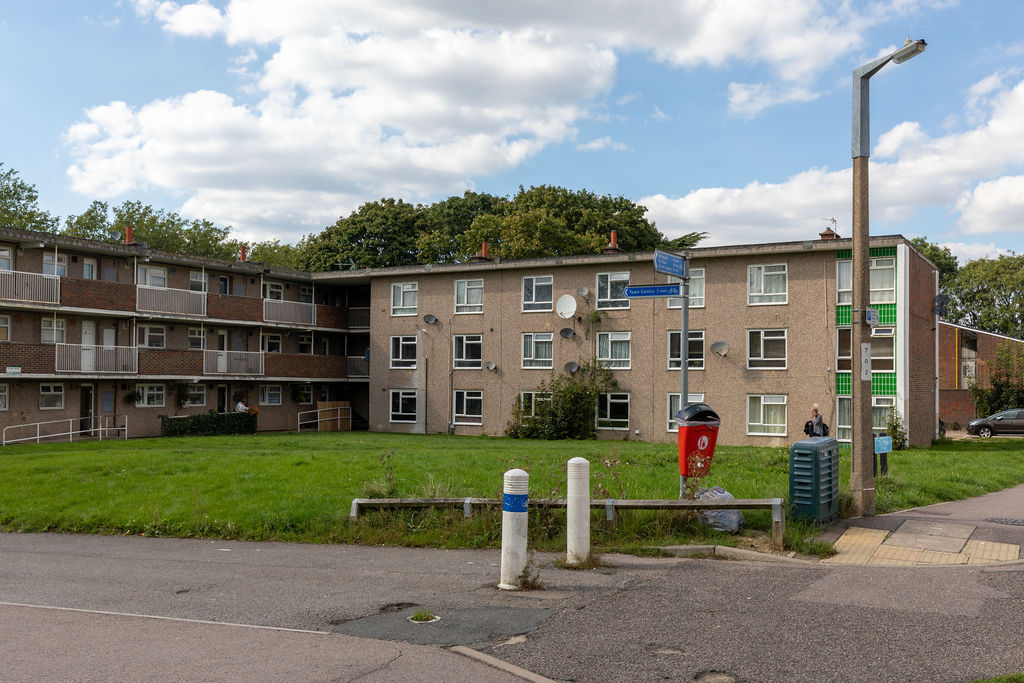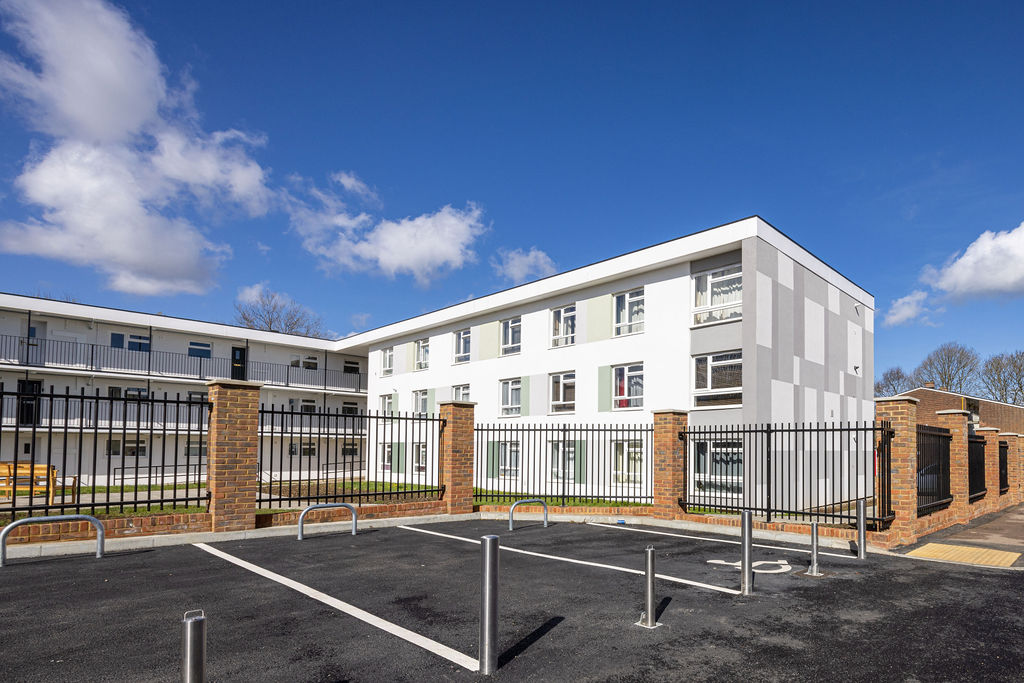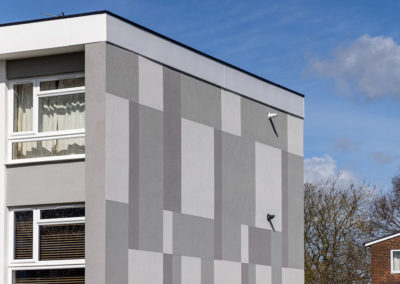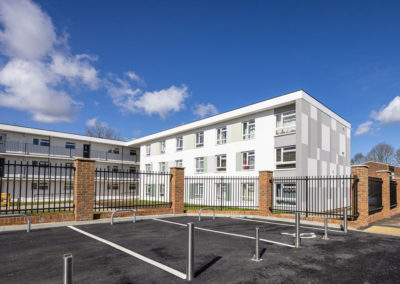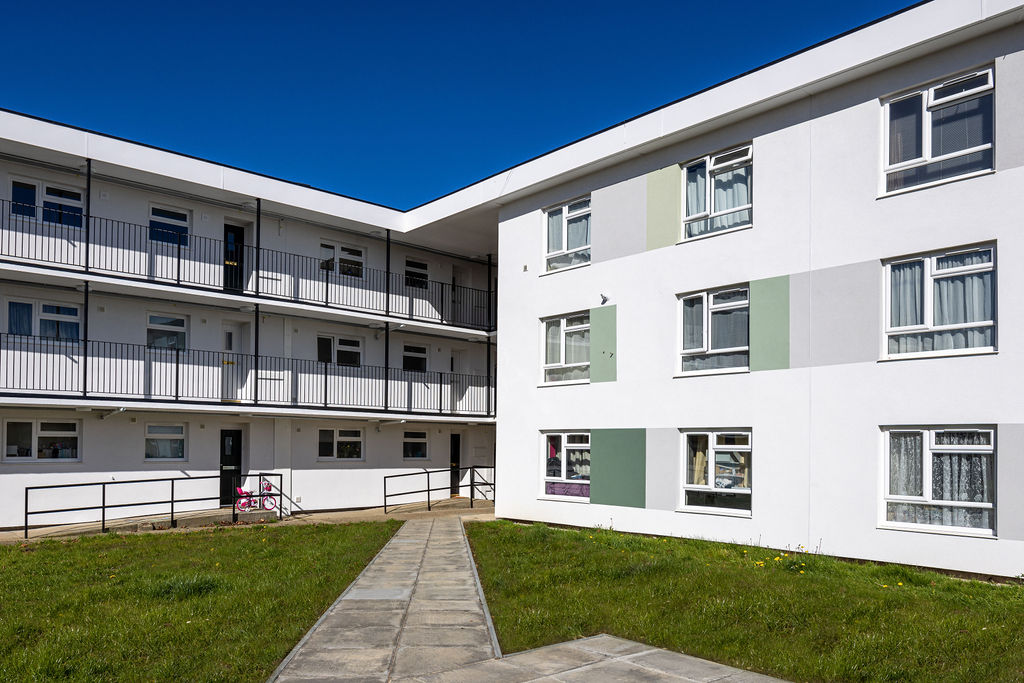INCA Case Study: The Hides, Harlow, Essex
The Hides, Harlow, Essex
 Project Type: Refurbishment
Project Type: Refurbishment
Building Type: Low Rise, Residential
Architect: studioap
System Designer: Saint-Gobain Weber
Installer: P J Mear
System & Finish: webertherm XM + webersil TF silicone render
U-value Achieved: 0.29 W/m2K
Background to the project
A complex of low-rise flats in Harlow has been refurbished to provide residents with more energy efficient homes that also enhance the appearance of the local area.
Harlow was designated a town in March 1947 as part of the government’s scheme to relieve overcrowding in London. Sir Frederick Gibberd was appointed as the architect-planner to draw up the new town masterplan that would house 60,000 people.
Now, Harlow is home to more than 85,500 people and some of the buildings in the town are around 75 years old. To bring these older buildings in to line with standards of new build properties, Harlow Council approached contractor Durkan to refurbish 30 flats within The Hides development which was originally built in the 1950s.
The council wanted to provide more energy efficient homes for its residents, while also refreshing the local area in a bid to tackle anti-social behaviour. The brief was to extend the life of the original building by using products that would improve its thermal performance and provide a more pleasant place for people to live.
From a design perspective, the council wanted to add a modern twist to the flats by using geometric colour blocks on the gable ends, road and courtyard facing elevations.
The solution and specification
Saint-Gobain Weber’s webertherm XM was specified for the project because it is a high-performance EWI system and fulfilled the criteria for the scheme. The system has all the required testing certification for fire as well as BBA approval.
The system build-up is formed of the following layers:
- A 110mm thick mineral fibre insulation was mechanically fixed to the substrate to achieve the required U-value target specified by London-based architect studioap.
- weberend LAC rapid render was then applied with alkaline resistant glass fibre meshcloth embedded, followed by another pass of weberend LAC rapid prior to the final finish. As a rapid drying, polymer-modified adhesive render coat, weberend LAC rapid does not require primer before overcoating with a decorative finish therefore saving many hours in drying time compared with other products.
- To complete the system, a textured silicone render finish webersil TF in Winter White was chosen to give the buildings a crisp and clean aesthetic. The finish is highly weather resistant, vapour permeable and is UV stable, helping to protect the building fabric, reducing the need for maintenance and improving durability.
The installation and challenges on site
Building restoration specialists PJ Mear were appointed by the main contractor Durkan to install the webertherm XM EWI system. Prior to any works starting, Weber carried out a series of toolbox talks to the contractor’s site management team so they fully understood the system specification required for the project.
The EWI system chosen meant that very little preparation was required, just the application of a fungicidal wash before the EWI system was applied.
Structural engineers Michael Aubrey Partnership calculated the wind loads in line with BS 1991 1-4. A fixing pattern of four initial fixings and two inserted through the mesh cloth coat in the system was used to achieve the required wind load resistance
Vented boxing was installed to cover exposed gas pipes in the communal walkways that pass under some of the flats, providing an attractive solution to a safety issue. The vented boxing required loose fill insulation to mitigate any cold bridging.
PJ Mear used webersil TF in a range of colours – including Silver Grey, Frosted Fern and Hurricane Skies – to create the geometric design on the gable ends and front elevations.
This required careful consideration and it was critical for Weber to approve the use of tape joints where different colours abutted to ensure the EWI system was not compromised in any way.
The new thermal improvements and design features incorporated in the refurbishment aimed to eliminate cold bridging completely. This was achieved by bringing the new windows out to be in line with the façade to remove the window recess which reduced heat leakage. A similar principle was employed both at roof level and below the damp proof course where the EWI was extended to increase thermal efficiency as well as improve air tightness.
To maintain positive relationships with the residents, a liaison officer made regular contact throughout the works to address any issues and share when access to communal walkways would be limited for safety in advance of any temporary closures. This helped to keep the impact of construction works to a minimum.
Problems overcome
As with any refurbishment project, working with buildings constructed decades ago using older methods and built to different standards presents its own set of challenges.
A combination of original build methods meant that the PJ Mear team worked closely with Weber application managers to address this and ensure a safe, compliant EWI system was installed.
The Hides was built using Wimpey No Fines construction which posed an issue when it came to how the EWI system would be fixed to the existing structure. Due to the nature of the concrete panels, specialist fixings were required to ensure a robust application.
There were also areas with a brick skin which needed an alternative fixing. The fixing specified was a rebated fixing with a 35mm embedment into the brick, and a 65mm embedment into the No Fines concrete.
The end result
In addition to the EWI system, the scheme included a new roof, replacement of windows and front doors. New communal lighting, fencing safety rails and a new door entry system were also installed to enhance security and make residents feel safer.
While aesthetics and security instantly improved the area, the installation of the EWI system has provided long-term energy efficiency benefits that will help residents combat rising fuel bills.
For areas with external brick, the previous U-value was 1.84 W/m2K and was improved to 0.29 W/m2K after the installation of the EWI. The U-value for the No Fines area was originally 1.93 W/m2K but was improved to 0.29 W/m2K post-EWI installation.
Taking a ‘fabric first’ approach on this refurbishment by improving the insulation has made the flats more comfortable for residents by keeping them warmer in the winter and cooler in the summer.
The refurbishment and clean modern aesthetics has huge social value and will improve both the mental and physical wellbeing of The Hides’ residents and the wider community. The project has since provided a blueprint of best practice for Harlow Council.
Work on the project started in August 2021 and was completed in February 2022.
Quotes
Brady Burdett, Estimating Director at PJ Mear, said:
“The dated nature of the building prior to the refurbishment works meant that radical change was required to bring the building to a modern, revitalised look. The plan for the flank walls to feature a multicoloured render pattern was an instant attraction to us and we knew that this was something that we would relish if given the opportunity to be involved. Having finished this project and now reflecting, we feel as though this was a huge success and has really given The Hides a new lease of life and something to really be proud of and to live in.
“This project featured a much more colourful and vibrant pattern on the flank walls as opposed to our normal projects that will typically finish the entire building in one colour. Furthermore, working with the Durkans site team enabled this project to run very smoothly and professionally. We always appreciate the opportunity to work directly with them”.
Kingsley Ogalanya, Site Manager for Durkan, said:
“The combination of new doors and windows, alongside the new external wall insulation and render system will make a significant difference to the insulation, air tightness and energy efficiency of the properties. At a time when so many people are struggling with energy bills, this sort of work is critical”.
Steve Page, Director of Refurbishment at Durkan said:
“We chose P J Mear as we have used them regularly over the years as external repair specialists. For such an important scheme, where the intricacies of fine detailing regarding finish was required, we had no hesitation in selecting them as our preferred contractor.”
Speaking to local paper Your Harlow, Councillor Simon Carter, Cabinet Member for Housing, said:
“The contractors, Durkan, have done an excellent job in particular with the detail work around the external cladding and worked well with residents during this disruptive period.
“This smart looking building has revitalised a tired-looking part of the estate and will improve the quality of life for our residents.”
“We have lived here for three years now. When we moved in, I was embarrassed to say I live at the Hides, and my family was worried because the flats looked so rundown. Now I am proud to be living in the Hides – the flats look amazing, they look so different and bright”.

